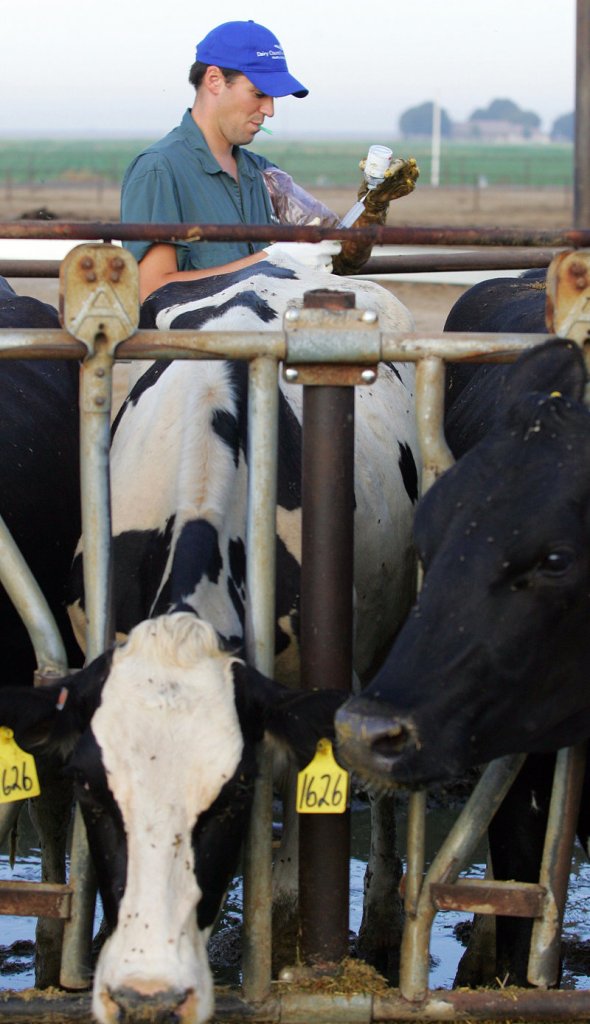FRESNO, Calif. – Stuart Hall doesn’t mind the triple-digit temperatures, the flies or the occasional temperamental cow.
“This is a physical job,” said Hall, a Visalia, Calif.-based farm veterinarian. “But this is what I love to do.”
Agricultural leaders wish there were more like him.
The vast majority of veterinarians choose to take care of dogs and cats, not cows, pigs and chickens.
The trend has raised concerns among animal-health experts who worry that there won’t be enough farm veterinarians to fill the expected vacancies at key federal agencies responsible for protecting the nation’s food supply.
Nearly 30 percent of the veterinarians at the federal level, including at the Food Safety and Inspection Agency, are eligible to retire in the next three years.
Rural communities also are feeling the squeeze.
The American Veterinary Medical Association estimates that more than 1,300 counties in the U.S. don’t have a farm veterinarian.
“The demand and need for services is critical,” said Gina Luke, assistant director in the government relations division of the AVMA in Washington, D.C.
“We are talking about making sure we have enough people to treat animals, and make sure that our food supply is safe.”
For years, interest in becoming a large-animal veterinarian has gradually been waning.
Veterinary schools are seeing fewer students with farm backgrounds. At the same time, the pet industry has exploded. An estimated $3.4 billion was spent on pet services last year, including trips to the vet.
The lure of having a staff and working in an air-conditioned office has become a strong attraction for students, as does the prospect of an income that will help pay for their education — a cost that can be more than $100,000.
The average salary for small-animal vets is $64,744, compared to $57,745 for large-animal vets, according to a 2008 survey by the American Veterinary Medical Association.
“As vets, the small-animal practice looks pretty attractive from a quality-of-life point of view,” said Hall, who works for Lone Oak Veterinary Clinic in Visalia.
From 1998 to 2009, the number of companion-animal vets has climbed to 47,118 from 30,255, while the number of farm-animal vets has dropped to 5,040 from 5,553, according to the American Veterinary Medical Association. Complicating the issue is the graying population of farm-animal vets. Half are older than 50. Only 4.4 percent are younger than 30.
“There are folks who are looking to retire or sell their practice and they are finding it challenging to hire someone to take their place,” said David Kirkpatrick, spokesman for the American Veterinary Medical Association.
Young veterinarians are more likely to take a job in a city and not in the rural areas where they often drive long distances to see their clients. Many of those rural areas are underserved, say veterinary industry officials. About 500 counties in the nation with large-animal populations have no veterinarian.
Industry officials, congressional leaders and veterinary schools are responding to the need for more animal doctors with legislative remedies and outreach programs.
At the University of California-Davis School of Veterinary Medicine, vet school applicants interested in becoming farm-animal vets have an admissions edge.
“We have some undergrads who have not been to a farm or even seen a large farm animal,” said Terry Lehenbauer, an associate director at UC-Davis’ Veterinary Medicine Teaching and Research Center in Tulare, Calif. “So we are having to do a better job of selling our program.”
To help boost the number of farm-animal vets, federal legislators have introduced several bills, including the Veterinary Services Investment Act, which is aimed at recruiting veterinarians, helping vets expand their practice and providing nontuition financial aid for students.
The bill has passed the House of Representatives and is awaiting approval in the Senate.
If approved, it would complement a federal loan-repayment program that provides students up to $75,000 in exchange for agreeing to work in an underserved area for three years.
Lehenbauer, who was on the program’s selection panel, said helping students defray some of the cost of their education is an important factor in attracting more veterinarians.
This year, more than 500 students applied for the repayment program, and between 60 and 80 students will receive funding, Lehenbauer said.
“Money can be a real magnet,” Lehenbauer said. “And we are already seeing lots of interest in this.”
Send questions/comments to the editors.



Success. Please wait for the page to reload. If the page does not reload within 5 seconds, please refresh the page.
Enter your email and password to access comments.
Hi, to comment on stories you must . This profile is in addition to your subscription and website login.
Already have a commenting profile? .
Invalid username/password.
Please check your email to confirm and complete your registration.
Only subscribers are eligible to post comments. Please subscribe or login first for digital access. Here’s why.
Use the form below to reset your password. When you've submitted your account email, we will send an email with a reset code.